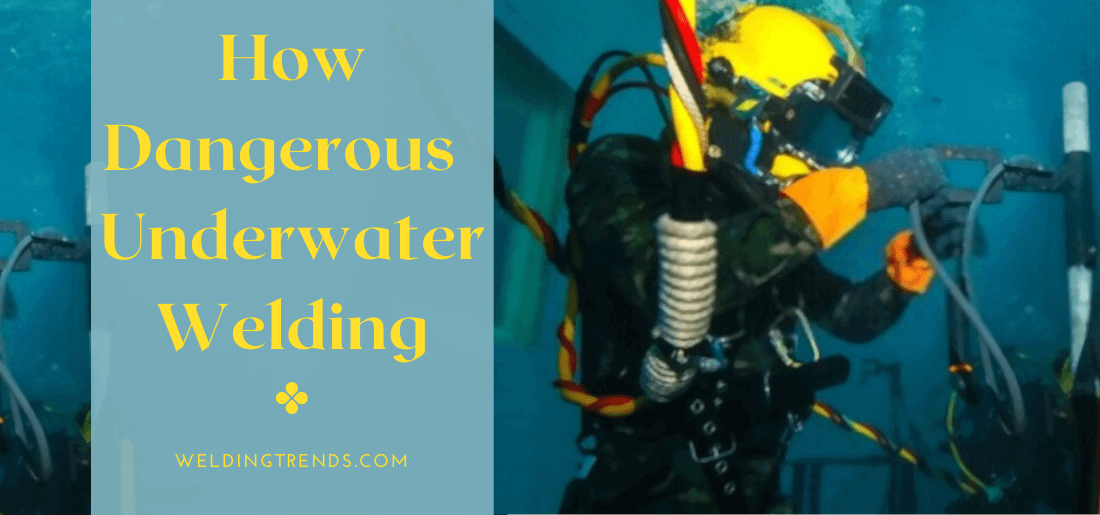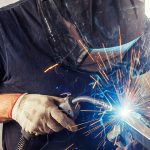Underwater welding is also known as Hyperbaric welding which is a type of welding performed underwater or at raised pressures. Underwater welding is used to repair pipelines, offshore oil drilling rigs, ships, dams, locks, sub-sea habitats, and nuclear power facilities. The most common material that needs welding is steel.
Underwater welders are given special training to become professional trainers and then are made to learn commercial diving. They are taught all the necessary precautions and safety measures as it is a very dangerous and risky profession. It is surely a well-paid job but all of this is because of the risk, this underwater welding job comes with.
If you want to know more about underwater welding, how dangerous is underwater welding, what can be the possible risks, what are the types of underwater welding or is welding dangerous for your health, then keep reading this informational guide that we jotted down after a lot of research and hard work.
What type of Welding is used underwater?
There are two types of underwater welding performed according to need are known as dry welding and wet welding.
1- Dry welding
Dry welding is also called Hyperbaric welding that is done in a chamber around the place that needs welding with a gas mixture filled in it at raised pressures. The chamber is sealed to keep the pressure that is necessary for welding.
The most common in dry welding is Gas tungsten arc welding (GTAW). There are other methods also that can be used such as flux-cored arc welding (FCAW), plasma arc welding (PAW), shielded metal arc welding (SMAW), and gas metal arc welding (GMAW). The method is selected based on needs and requirements.
The safety measures or precautions that dry welding include are oxygen or helium gas is filled in the chamber, to prevent decompression sickness chamber should be pressurized at the right level, and the welders or drives must follow precatory measures.
2- Wet welding
Wet welding is the main type of underwater welding and is performed according to the level of access and urgency to fix or repair something. Wet welding is usually used as the last option for repairing underwater as it comes with many risks and dangers.
Shielded metal arc welding is the most common and regularly used method in wet welding as it is multipurpose and cost-effective than other risky methods. In this method, an electrode is energized by the power supply to create an electric arc. The arc is created between the welding part and electrode to melt and bond the filler substance at the repairing point.
The safety measures that are considered in wet welding are to ensure the work field for any barriers or hindrances. The welder also needs to make sure that the electrode, base, or any metal surface is clean. The main part of safety measures is for the welder to follow the instructions to avoid any mishap.
What are the risks with Underwater Welding?
Underwater welding or Hyperbaric welding is a very dangerous and risky job as it involves both water and electricity. The biggest hazard of underwater welding is the risk of electric shocks.
There are many other hazards or risks involved in underwater welding. Here is detailed information on how dangerous is underwater welding.
1) Electric Shock
Electrocution is the biggest threat in underwater welding as water has less resistance against electricity and electricity can easily pass through water that can cause an electric shock to the welder. This can also lead to the death of welders or divers.
To prevent this from happening, the welder should check for his tools and equipment and must insulate them properly. He must also use rubber gloves and a suit, not to cause an accident.
2) Decompression sickness
Decompression sickness also known as the blends occurs as a result when divers quickly rise to the surface that dissolves gases in their bloodstream. This can lead to joint pain, rashes, paralysis, or it can also result in death.
Decompression sickness is diagnosed if the welder has pain or itching in the skin, lungs, ears, brain, joints, or spinal cord.
3) Explosion
The explosion can be another risk in underwater welding and happens because of a combination of oxygen and hydrogen in a large amount. These gases are released from ruptures and create a small popping sound.
This should be considered as alarming and immediately check for leakages or where these gases are combining as it can cause big explosions too if ignored.
4) Hearing Impairment
Hearing impairment can happen when you stay under high pressure for very long. It happens to divers or welders when they have to work or repair underwater for long. This can lead to temporary hearing impairment or permanent hearing impairment. It can also cause lung or ear damage.
5) Drowning
Drowning is always a risk when you are going underwater. Even if you are an experienced diver, there is still a risk of drowning as you can get tangled in obstacles, wires of your equipment, or ill-maintained equipment. To make sure this does not happen, always check your equipment and oxygen supply tank.
6) Marine life
Marine life can also be seen as a threat if you are working on underwater oil shores. The light can attract dangerous animals like sharks or planktons to attack you and cause an accident.
7) Hypothermia
Hypothermia is caused when a diver or welder remains in cold water for a long time. When a diver or welder stays in cold water for long, the heat is driven away from the body making it extremely cold. This can lead to organ failure or metabolism issues.
Hypothermia can be prevented by wearing a fully insulated rubber for protection and not letting cold water drive your temperature away.
Unrevealed Questions about Underwater Welding
We discussed some of the important things and factors about underwater welding, types of underwater welding, and its risks.
In this section, we tried to answer a few questions that might have arisen in your mind or might be confusing you regarding underwater welding so it can help clear your thoughts or confusion.
Is there any die possibility from underwater welding?
Underwater is considered to be one of the most dangerous jobs in the world. There can die a possibility from underwater welding due to electric shock, hyperthermia, explosion, decompression sickness, and other hazards. According to some studies, underwater welders have the highest fatality rate as compared to other jobs.
What is the death rate of underwater welding?
The death rate of underwater welding is the highest according to industry investigation. It shows that that the fatality rate or death rate of underwater welders is 15 percent more which is 1000 times greater as compared to a police officer job.
Why is underwater welding so bad for you?
Underwater welding can be bad for you as it comes with high risks and life-threatening hazards.The risk involves electric shocks, explosions, hyperthermia, drowning, decompression sickness.
It also involves other risks such as hearing impairment, paralysis, joint pain, and many more. If you do not pay complete attention while working, it may affect you.
Does underwater welding shorten your life?
Underwater welding as such cannot reduce or shorten your life span. It is considered dangerous and risky because of the life-threatening hazard it comes with. There are 15 percent more chances of death than any other occupation.
Is underwater welding worth it?
Underwater welding can worth it if you like it very much, it is your dream job, or love doing challenging and risk work. It looks simple but it comes with many dangers and hazards like marine life can attack you or some mishap can happen that is life-threatening.
Also, it can be worth it in the sense that underwater welders get to earn more.
Why choose underwater welding?
The advantage of underwater welding that makes you choose it, is that it is a very well-paid job and people can get more wages as compared to simple or regular welders and many other jobs. You can also learn a variety of things by working with marine life and can also explore nature.
Final Thoughts:
Underwater welding is a very risky as well as a well-paying job. A lot of people choose to be underwater welders because this job seems to be exciting and challenging. There is a high demand for underwater welders in different industries.
If you want to become an underwater welder, you must be specialized and receive training in both welding and diving. You must also learn all the safety protocols and precautions.
We discussed some of the very important questions in the world of underwater welding. The main questions that this article includes are how dangerous is underwater welding or is welding dangerous for your health.
As you read the answers to these questions in detail, now you would have known all the necessary and vital information. We hope that we were beneficial for you in your problem.
Related Articles:
How To Become A Certified Welder?
How To Weld Brass? Most Effective Method To Discuss




